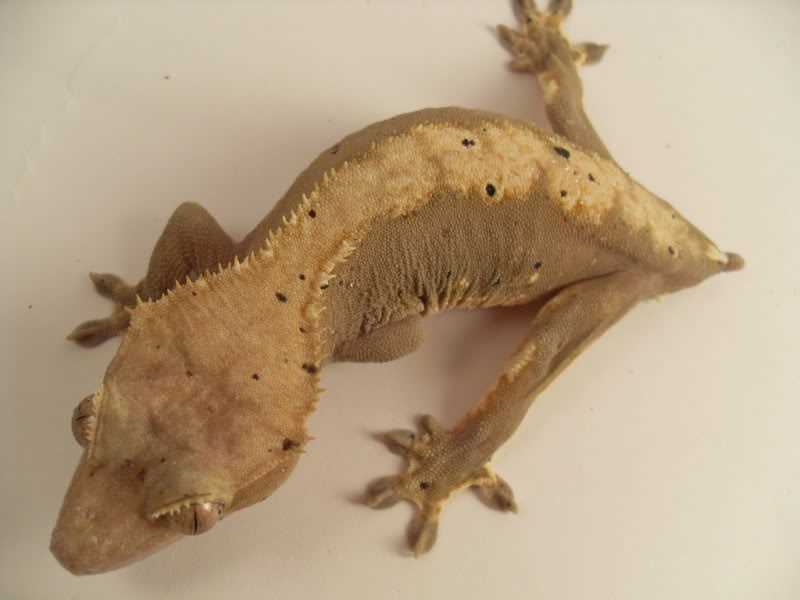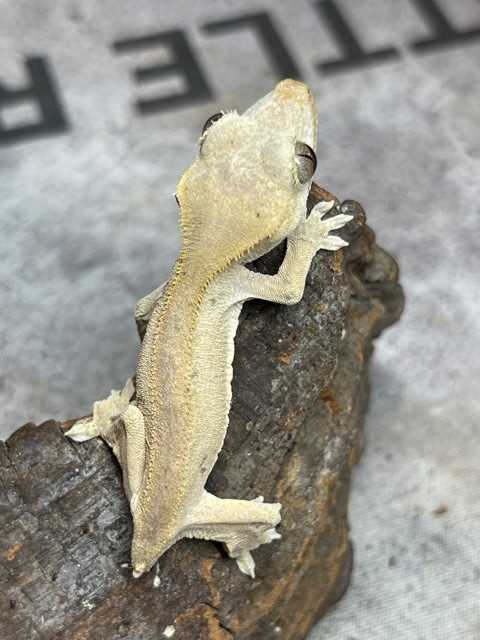Crested Gecko No Tail
1. Causes of Tail Loss
Crested geckos may lose their tails due to a number of reasons. One common cause is stress or injury, such as being handled roughly or attacked by another gecko. Tail loss can also be a natural defense mechanism for crested geckos to escape from predators.
2. Care for Crested Geckos with No Tail
Proper nutrition is crucial for the overall health of crested geckos, including those without tails. Offer a balanced diet consisting of commercially available crested gecko food, supplemented with occasional live insects. Maintaining proper humidity levels and temperature range is also essential for their well-being.
3. Considerations for Crested Geckos without Tails
Crested geckos without tails may have slightly different behaviors compared to their tailed counterparts. They may rely more on climbing and jumping to navigate their surroundings, and may also have a slightly different balance. Keep an eye on their movements and adjust their habitat accordingly to ensure their comfort and safety.
4. Tail Regeneration in Crested Geckos
Unlike some other reptiles, crested geckos do not naturally regenerate their tails once they are lost. However, the tail stump may slowly heal and form a small, rounded tip over time. This stub may not serve the same functions as a full tail, but it can still aid in balance and movement.
5. Preventing Tail Loss in Crested Geckos
6. Handling Crested Geckos with No Tail
Causes of Tail Loss in Crested Geckos

There are several reasons why a crested gecko may lose its tail:
1. Predators
When faced with a predator, such as a larger reptile or a bird, a crested gecko may drop its tail to distract the predator and increase its chances of survival. The tail continues to wiggle even after detaching, attracting the predator’s attention while the gecko makes a quick escape.
2. Stress or Injury
Stressful conditions or injuries can also cause a crested gecko to lose its tail. Improper handling, such as pulling or grasping the tail, can lead to tail loss. In some cases, tail loss may occur due to rough mating behavior or territorial disputes between geckos.
3. Incomplete Regeneration
Although crested geckos have the ability to regenerate their tails, the regenerated tail is often shorter, stubbier, and less vibrant in color compared to the original tail. In some cases, the tail may not fully regenerate at all, resulting in a gecko without a tail.
Care for Crested Geckos with No Tail
When taking care of a Crested Gecko with no tail, there are a few important considerations to keep in mind. While the absence of a tail may not impact the gecko’s overall health or well-being, there are some specific steps you can take to ensure its comfort and safety.
- Provide a suitable habitat: Make sure the gecko’s enclosure is spacious, well-ventilated, and equipped with appropriate hiding spots, branches, and foliage. The gecko without a tail may rely more on its climbing abilities, so providing plenty of vertical space is essential.
- Monitor temperature and humidity: Crested Geckos require a temperature range of 72-78 degrees Fahrenheit (22-25 degrees Celsius) during the day and slightly cooler temperatures at night. Additionally, maintaining a humidity level of 50-70% is crucial for their overall health.
- Feed a balanced diet: Offer a varied diet consisting of commercially available Crested Gecko diets, supplemented with occasional live insects. Provide fresh water daily and ensure the gecko has access to calcium and vitamin supplements to support its bone health.
- Handle with care: When handling a Crested Gecko without a tail, it’s essential to be gentle and avoid any unnecessary stress. Avoid pulling or tugging on the gecko’s remaining tail, as it may be more delicate than a fully intact tail.
- Watch for signs of aggression: Without a tail, Crested Geckos may have altered behaviors when interacting with other geckos or during feeding. Keep an eye out for any signs of aggression or stress and be prepared to separate geckos if necessary.
- Regular veterinary check-ups: Just like all Crested Geckos, individuals without tails should receive regular veterinary examinations to ensure their overall health and address any potential issues.
By following these care guidelines, you can ensure that your Crested Gecko without a tail remains healthy, happy, and comfortable in their habitat.
Considerations for Crested Geckos without Tails

When caring for a crested gecko with no tail, there are a few considerations that should be taken into account to ensure their well-being and overall health.
- Escape Prevention: In the wild, a gecko’s tail acts as a distraction and defense mechanism against predators. Without a tail, their ability to escape from potential threats is compromised. It is crucial to ensure the enclosure is escape-proof by checking for any gaps or openings that the gecko can squeeze through.
Overall, caring for a crested gecko without a tail requires special attention to their balance, safety, thermoregulation, social interactions, and handling. By providing a suitable environment and being mindful of their unique needs, these geckos can still live a comfortable and fulfilling life without a tail.
Tail Regeneration in Crested Geckos
One of the fascinating abilities of crested geckos is their capability to regenerate their tails. When a crested gecko loses its tail, whether due to injury or stress, it can regrow a new one in a process called “autotomy.” Autotomy is a defense mechanism that allows the gecko to detach its tail from its body, distracting predators and giving the gecko a chance to escape.
During the regeneration process, it is essential to provide the crested gecko with a proper diet and a stress-free environment. A nutritious diet rich in calcium, vitamins, and minerals will promote healthy regrowth. It is also crucial to ensure that the gecko’s enclosure is clean and properly maintained to prevent any infections or complications during the healing process.
While the tail regenerates, it is recommended to minimize handling and stress on the gecko. Excessive stress or rough handling can slow down the regrowth process or even prevent the tail from regenerating fully. It is crucial to give the gecko enough time and space to heal naturally.
If the tail regeneration process takes longer than expected or if there are any signs of infection or abnormal growth, it is advisable to consult a veterinarian who specializes in reptiles. They can provide further guidance and ensure the gecko’s health and well-being.
Preventing Tail Loss in Crested Geckos
There are several reasons why crest geckos might lose their tails. One of the most common causes is stress. If a gecko feels threatened or is handled roughly, it may drop its tail as a way to escape from a potential predator. Other causes of tail loss include fighting with other geckos, improper handling techniques, and accidents within their enclosure.
Proper Handling Techniques
Regular Health Checkups
Regular veterinary checkups are vital for monitoring the overall health and well-being of your crested gecko. A qualified reptile veterinarian can identify any signs of illness or stress that may contribute to tail loss. By catching any potential issues early on, you can take appropriate measures to prevent tail loss and provide the necessary care for your gecko.
Additionally, it is essential to provide a suitable enclosure for your crest gecko. This includes a proper temperature and humidity level, spacious living area, and appropriate hiding spots. A comfortable and secure environment will help reduce stress and prevent unnecessary accidents or fights that may lead to tail loss.
Regularly Check the Enclosure
Regularly inspecting the gecko’s enclosure is crucial to identify any potential hazards that might lead to tail loss. Make sure there are no sharp objects or rough surfaces that could cause injuries. Also, check for any signs of aggression or bullying if you keep multiple geckos together. If any issues are observed, it is recommended to separate the geckos or modify their environment accordingly.
Handling Crested Geckos with No Tail
When picking up a crested gecko with no tail, it is best to approach them from the side rather than from above. This will help to reduce any stress or anxiety they may feel during the handling process. Slowly and gently scoop them up, supporting their body with your hands. Avoid grabbing or squeezing their tail area, as it may cause discomfort or pain.
When handling crested geckos with no tails, it is crucial to wash your hands thoroughly before and after each interaction. This is important to prevent the transmission of any potential bacteria or diseases between you and the gecko.
Lastly, always be mindful of the individual crested gecko’s behavior and body language while handling them. If they show signs of stress or discomfort, such as hissing, biting, or trying to escape, it is best to gently return them to their enclosure and try handling them at another time.
Overall, handling crested geckos without tails requires patience, gentleness, and respect for their unique needs. By following these guidelines, you can provide them with a safe and comfortable handling experience.

I’m Lena Adams—a product of an unconventional upbringing in the African wilderness. My father, a daring explorer of African wildlife, sparked my fascination with reptiles, a passion that intertwined with the tragic loss of my mother during an expedition, leaving an indelible mark on my life. Driven to understand the creatures that captivated my parents, I embarked on my journey, sharing insights about reptiles, frogs, and lizards on my website. Through my explorations and conservation efforts, I honour my family’s legacy while seeking connections—to the creatures, nature, and the mother whose presence I yearn to understand.
